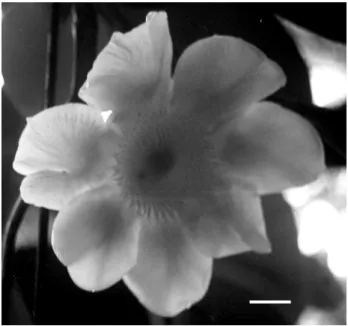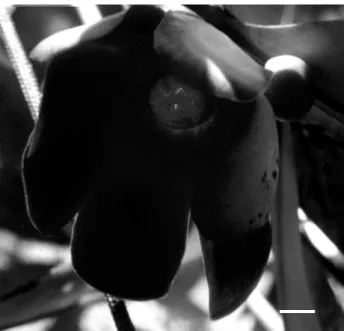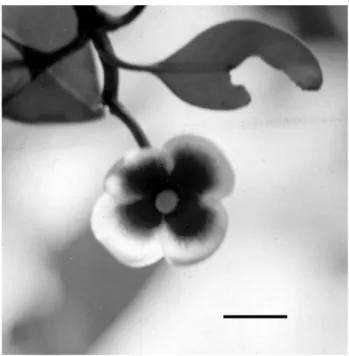2 5 9 2 5 9 2 5 9 2 5 9
2 5 9 VOL. 36(2) 2006: 259 - 264
Ana Claudia KAMINSKI1, Maria Lúcia ABSY2
ABSTRACT
Observations on bees visitors to three species of Clusia (Clusiaceae) flowers in the Reserva Adolpho Ducke, Manaus, Amazonas, Brazil were made during three two-week periods. The three species of Clusia, namely C. grandiflora, C. panapanari and C. insignis, presented variations regarding the species of bee visitors. A total of 23 bee species visited the three species of Clusia. The Euglossini and Meliponinae bees were the most frequent visitors of the Clusia flowers. Bee collecting behavior of floral resources is described.
KEY WORDS
Clusia, flowers visitors, bees.
Abelhas visitantes de flores de três espécies de
Clusia
(Clusiacea) na
Amazônia Central
RESUMO
Durante seis semanas foram realizadas observações das abelhas visitantes de flores de três espécies de Clusia (Clusiaceae), na Reserva Florestal Adolpho Ducke, em Manaus. As três espécies de Clusia: C. grandiflora Splitg., C. panapanari (Aubl.) e C. insignis Mart. apresentaram diferenças com relação às visitas de espécies de abelhas, tendo sido visitadas por 23 espécies. Abelhas Euglossini e Meliponinae foram os visitantes mais freqüentes em flores de Clusia. O comportamento de coleta de recursos florais é descrito.
PALAVRAS-CHAVE
Clusia, visitantes florais, abelhas.
2 6 0 2 6 0 2 6 0 2 6 0
2 6 0 VOL. 36(2) 2006: 259 - 264 KAMINSKI & ABSY
INTRODUCTION
The primary bee feeding resources include nectar and pollen (Roubik, 1989; Nogueira-Neto, 1997). Gums and resins are used as nest construction material and defensive antimicrobial compounds (Armbruster, 1984; Roubik, 1989). Although the use of resins by bees is widely known, it has been largely assumed that these materials were only collected from resinous plant wounds or vegetative structures that have resin protective coatings (Armbruster, 1984).
Flowering plants species producing terpenoid resins are rare (Armbruster & Webster, 1979, Gonçalves-Alvim, 2001).
Dalechampia L. (Euphorbiaceae) (Armbruster, 1984), Clusiella
Planch. & Triana and Clusia L. (Clusiaceae) (Bittrich & Amaral, 1996, 1997; Gonçalves-Alvim, 2001) are the only examples known.
The genus Clusia is mostly found in the Americas. It comprises about 250-300 species with a distribution from southern Florida (Key West) to southern Brazil (Mariz, 1974; Bittrich & Amaral, 1997), two species in New Caledonia, and one in Madagascar (Mariz, 1974). Life forms include hemiepiphytes (sometimes stranglers), lianas, shrubs and trees. Generally, Clusia species produce a large amount of viscous latex on all organs. The flower morphology is variable, and the petals may be white, yellow, pink, red or violet (Mariz, 1974) While most Clusia species are dioecius, a few are hermaphrodite or include flower-bearing hermaphrodite strains (Maguire, 1959; Mariz, 1974; Bittrich & Amaral, 1996, 1997). The genus is known for the wide range of its androecium morphology (Bittrich & Amaral, 1997).
The objectives of this study are to know the flower visitors of three species of Clusia, with emphasis on resin-collecting bees and to describe their behavior.
MATERIALS AND METHODS
In the present study, the flower visitors on three species of
Clusia, namely C. grandiflora Splitg., C. panapanari (Aubl.) Choisy and C. insignis Mart., were observed between April and September 2001 at the Reserva Adolpho Ducke in the vicinity of Manaus, Amazonas, Brazil, close to landmark 203 (02º 55' 50,5" S, 59º 58' 14,9" W). Vouchers of the species are deposit at Herbarium of the Instituto Nacional de Pesquisas da Amazônia (INPA) (numbers 209.349, 209.350, and 209.351). Were observed one individual male of each species.
Flower visitor abundance and behavior during anthesis were recorded, as well as material collected by the bees (pollen, resin and latex). Some flower visitors were captured and mounted for later identification. Bee activity was observed from 6.00 a.m. to 6.00 p.m. Attention was paid in differences among visitors along the different times of the day.
In order to detect if morphological changes in the flowers had any influence on the visiting bees, some flowers of C. panapanari were selected for observation for more than one day. This procedure was not followed for the other two species since the flowering and falling occurred in the same day.
RESULTS
Clusia grandiflora
The flowering of Clusia grandiflora (Figure 1) occurs from February to June (Mesquita, 1989; Bittrich & Amaral, 1997). Flowers bear white petals, which are pink toward the base of the adaxial surface. It is 16 cm in diameter. In male flowers, the stamens are connate at the base and form a crown-like structure around the resin-producing staminodes. The connectives are long awning-like tips which project inwards narrowing the access of the flower visitors to the interior of the flower. The connectives produce droplets of apparently an oil liquid, observed also by Bittrich & Amaral (1997). On the day of anthesis, the staminodes form a plate covered with yellowish opaque resin. The flowers open at about 3.00 a.m. and the resin production starts at about 11.00 p.m. the day before (Bittrich & Amaral, 1997).
Figure 1 - Flower of Clusia grandiflora. Scale bar = 2 cm.
The flower visitors recorded were females of Euglossini (Euglossa piliventris, Euglossa cf. avicula, Euglossa cf. stilbonota
and one unidentified species of Euglossa) and workers of Meliponinae (Partamona pearsoni, Nogueirapis minor, Trigona williana, Trigona fulviventris, Scaura tenuis, Plebeia sp. and
2 6 1 2 6 1 2 6 1 2 6 1
2 6 1 VOL. 36(2) 2006: 259 - 264 KAMINSKI & ABSY
In the early hours of the day, the Euglossini bees were the most abundant visitors, and only T. fulviventris and P. lurida
(Meliponinae) visited the flowers from 5.30 a.m. to 6.30 a.m. The smallest abundance of bees occurred from 11.00 a.m. to 3.00 p.m., when temperature was probably too high for the bee activity and there was a floral resource reduction.
The Euglossini bees collected resin and, indirectly, pollen. The morphology of the male flowers does not allow these bees to land directly on the resin plate. Therefore, they land on the stamens, and the pollen stays fixed to the body of the bees. When collecting resin, the bees make little balls with it in their mandibles, storing them temporarily in the basal region of the mandibles. Following the collection, the bees fly near the flower and move the resin ball from the mandible to one of the corbiculae. Euglossapiliventris is the major C. grandiflora bee visitor.The C. grandiflora main visitors in the early hours of the day were Euglossacf.avicula and Euglossacf.stilbonota. These species have a peculiar behavior of being attached either to petals or leaves lifting their bodies and cleaning their heads, thorax and wings with their legs.
On Meliponinae, the collecting behavior is the same, differing only in the way they move the resin ball from the mandible into one of the corbiculae. The Meliponinae remain resting on the resin. However, of all the Meliponinae observed visiting the flowers, only Partamona pearsoni, Trigona fulviventris,
Nogueirapis minor and Plebeia sp. actually collected resin.
Nogueirapisminor, besides resin, also collected latex from wounds on the branches.
The other three visiting species, Trigona williana,
Ptilotrigonalurida and Scauratenuis, were observed collecting only pollen. The former two collected the pollen fallen onto petals and leaves below the flowers with the mouthparts, and deposited it on the corbiculae. The later, Scauratenuis, has an enlarged basitarsis, adapted for scraping the leaves, to collect the fallen dry pollen (Laroca & Lauer, 1973).
We observed agonistic meetings intra and interspecifically. The Euglossini species does not allow for the approximation of the other bees.
Clusia insignis
The flowering of Clusia insignis (Figure 2) occurs from August to November (Bittrich & Amaral, 1997). Flowers bear wine-red petals inside and white petals outside. They are 9.5 cm in diameter. The morphology of the flowers is very similar to that of the C. grandiflora. The resin produced by the staminodes is lemon yellow and the resin plate is smaller. The flowers open at about 6.00 a. m.
In C. insignis, the number of bee species, which visited the flowers, was larger. We observed four species of Euglossini females (Euglossa piliventris, E. variabilis, E. mourei, and E. stilbonota), ten of Meliponinae workers (Melipona bradleyi, Trigona
fulviventris, Trigona williana, Scaura tenuis, Leurotrigona pusilla,
Plebeia minima, Plebeia sp., Trigonisca sp., Duckeola pavani,
Duckeola ghilianii and Ptilotrigona lurida), one of Halictidae female (Augochloropsis cf. illustris), and one of Megachilidae female (Anthodioctes sp.).
The bee pollen and resin collecting behavior is the same as that reported for C. grandiflora. In the early morning, between 6.00 and 7.00 a.m., the main visitors are P. lurida and Augocloropsis
cf. illustris. Before the anthesis, many bees (P. lurida and T.
williana) fly around the flowers. The large number of P. lurida
inhibits others bee, both stingless and orchid bees, from approaching, since this species is very aggressive. During this time, however, Euglossapiliventris was observed wounding the petals to collect resin.
The Halictidae Augocloropsis cf. ilustris collect pollen, only. These bees land on the connectives and collect pollen through vibration, or “buzz pollination”. This way, dry pollen gets released.
P. lurida, S. tenuis, L. pusilla, P. minima and Trigonisca sp. collected the pollen that stayed on the petals. These last four bees are very small (< 3 mm), and are expelled by P. lurida, but when the number of individuals of P.lurida declines, nearly 8.30 a.m., the visits of these species increase.
The Meliponinae species Meliponabradleyi, Plebeia sp. and
T. fulviventris were observed collecting resin. Trigonafulviventris
collected resin remained in the staminodes of the fallen flowers. In C. insignis, only Duckeolaghilianii and D. pavani were observed collecting pollen in the connectives. These two species collected the pollen mixed with apparently an oily liquid. The increase in their visits reduces the offer of dry pollen, thus, reducing the visits of Augocloropsis.
2 6 2 2 6 2 2 6 2 2 6 2
2 6 2 VOL. 36(2) 2006: 259 - 264 KAMINSKI & ABSY
Clusia panapanari
The flowering of Clusia panapanari (Figure 3) occurs from May to July. The flowers are white with an orange centre. It is 1.8 cm in diameter. The flowers are flat. The stout columnar stamens secrete resin mixed with pollen from their apex and do not have oil production, as the stamens are covered by resin. The flowers last up to three days, although the petals become increasingly brownish. The flowers open during the whole day.
and Roubik & Hanson (2004). Euglossini bees are considered effective pollinators of Clusia species, whereas Meliponinae bees are both considered as pollen thieves and as little effective pollinators in the tropical region (Armbruster & Webster, 1979; Mesquita & Franciscon, 1995; Lopes & Machado, 1998). We cannot state anything about pollination, because we only observed male individuals of Clusia. However, there are differences between the floral visitors recorded by us from that recorded by Bittrich & Amaral (1997), who stated that “only
Trigona sensu lato bees collected pollen from male flowers of C.
grandiflora, and this happened very rarely”. We don’t know whether Trigona sensu lato (sensu Bittrich & Amaral, 1997) refers to the genus Trigona or Trigonini. However, we observed frequently five genera of Meliponinae collecting pollen in C.
grandiflora and C. insignis: S. tenuis, P. lurida, L. pusilla, P.
minima, Trigonisca sp. and Trigona williana.
Euglossini bees touch the stamens while collecting resin. The drops of apparently an oil liquid present in these structures may help the pollen grains to stick to the body of the bees, making possible their transport. Meloponinae bees, such as
Trigona fulviventris, Plebeia sp. and Nogueirapis minor, do not touch the stamens; consequently, they do not transport pollen and are thus considered as resin thieves.
Mesquita & Franciscon (1995) and Bittrich & Amaral (1997) recorded that Ptilotrigona lurida collects resin in flowers of C. grandiflora, C. insignis and C. nemorosa. However, we observed this species collecting resin from C. panapanari, only. In C. grandiflora and C. insignis, this species was observed collecting fallen pollen in petals and leaves. During the study we do not observed P. lurida collecting resin. Nevertheless, individuals of this species tried to land either on the conectives or resin plate, but it failed. We think that the connectives surrounding the resin plate either impeded or difficult access to the resin.
Bittrich & Amaral (1997) noticed that bees showed little interest in the pollen of C. grandiflora when compared to other species of Clusia. We also observed this “preference”, because we observed only three species of Meliponinae collecting pollen from C. grandiflora, whereas eight species collecting from C. insignis in the same area, and, the number of individuals was much larger.
Different bee visiting patterns on different – sexed Clusia palmicida flowers are described by Gonçalves-Alvim (2001). It is also evident that there is a preference for different species of
Clusia shown by the floral visitors. This preference may be due to floral morphology (facility for collecting resources) or chemical compositions. Investigation of the chemistry of the floral resins indicated a correlation between the chemical composition, the taxonomic sections of Clusia and the pollinators (Nogueira et al., 2001). Differences between male and female flower resin Figure 3 - Flower of Clusia panapanari. Scale bar = 1 cm.
Only four species of Meliponinae were observed visiting C.
panapanari: Ptilotrigona lurida, Trigona fulviventris,
Frieseomelitta sp.and, rarely, Cephalotrigona femorata.
P. lurida visited the flowers from 5.40 a.m. to 5.30 – 6.00 p.m. A large number of these bees were observed in the early morning. The bees landed on stamens or petals and collected resin mixed with pollen while resting on it. C. femorata was recorded very seldom. Agonistic meeting was not observed, probably due to the great number of flowers.
The species Heteroptera, Reduviidae collected small quantities of resin from the flowers by putting it on the head, antenna, and legs. These insects approached the flowers to capture bees, especially Frieseomelitta.
DISCUSSION
2 6 3 2 6 3 2 6 3 2 6 3
2 6 3 VOL. 36(2) 2006: 259 - 264 KAMINSKI & ABSY
chemical composition are described by Lokvan & Braddock (1999) and Porto et al. (2000). However, bee preferences for collecting pollen from different flower species are unclear.
ACKNOWLEDGMENTS
The authors wish to thank CNPq (Process 471569/2001-1) for funding part of this study; Prof. Dr. João Maria Franco de Camargo, for the identification of the stingless bee species; Prof. Jorge Antunes and Dr. Conceição A. Absy for their help in the corrections of the English language.
LITERATURE CITED
Armbruster, W.S. 1984. The role of resin in angiosperm pollination: ecological and chemical considerations. Amer. J. Bot.,71(8): 1149-1160.
Armbruster, W.S.; Webster, G.L. 1979. Pollination of two species of Dalechampia (Euphorbiaceae) in Mexico by Euglossine bees. Biotropica, 11(4): 278-283.
Bittrich, V.; Amaral, M.C.E. 1996. Flower morphology and pollination biology of some Clusia species from the Gran Sabana (Venezuela). Kew Bulletin, 51(4): 681-694.
Bittrich, V.; Amaral, M.C.E. 1997. Floral biology of some Clusia species from Central Amazonia. Kew Bulletin, 52(3): 617-635. Gonçalves-Alvim, S.J. 2001. Resin-collecting bees (Apidae) on Clusia palmicida (Clusiaceae) in a riparian forest in Brazil. J. Trop. Ecol., 17: 149-153.
Laroca, S.; Lauer, S. 1973. Adaptação comportamental de Scaura latitarsis para coleta de pólen (Hymenoptera, Apoidea). Acta Biol. Par., 2(1, 2, 3, 4): 147-152.
Lokvan, J.; Braddock, J.F. 1999. Anti-bacterial function in the sexually dimorphic pollinator rewards of Clusia grandiflora (Clusiaceae). Oecologia, 119: 534-540.
Lopes, A.V.; Machado, I.C. 1998. Floral biology and reproductive ecology of Clusia nemorosa (Clusiaceae) in northeastern Brazil. Pl. Syst. Evol., 213: 71-90.
Maguire, B. 1959. A revision of Clusia sect. Polythecandra Pl. & Tr. Of the Guttiferae. Bol. Soc. Venez. Ci. Nat., 20: 363-370. Mariz, G. 1974. Chave para as espécies de Clusia nativas no Brasil.
Mem. Inst. Bioc. Univ. Fed. Pe., 1(1): 249-314.
Mesquita, R.C.G. 1989. A biologia reprodutiva de Clusia grandiflora Split.: variação individual e remoção de sementes. Dissertação de Mestrado, Instituto Nacional de Pesquisas da Amazônia/ Fundação Universidade do Amazonas. Manaus, AM. 110 pp. Mesquita, R.C.G.; Franciscon, C.H. 1995. Flower visitors of Clusia
nemorosa G.F.W. Meyer (Clusiaceae) in an amazonian white-sand Campina. Biotropica, 27(2): 254-257.
Nogueira, P.C.; Bittrich, V.; Shepherd, G.J.; Lopes, A.V.; Marsaioli, A.J. 2001. The ecological taxonomic importance of flower volatiles of Clusia species (Guttiferae). Phytochemistry, 56: 443-452.
Nogueira-Neto, P. 1997. Vida e criação de abelhas indígenas sem ferrão. Editora Nogueirapis, São Paulo, SP. 445 pp.
Porto, A.L.M.; Machado, S.M.F.; Oliveira, C.M.A.; Bittrich, V.; Amaral M.C.E.; Marsaioli, A.J. 2000. Polyisoprenylated benzophenones from Clusia floral resins. Phytochemistry, 55: 755-768.
Roubik, D.W. 1989. Ecology and natural history of tropical bees. Cambridge University Press. Cambrige. 514 pp.
Roubik, D.W.; Hanson, P.E. 2004. Abejas de orquídeas de la América tropical. Biología y guía de campo. INBIO, Costa Rica, 370 pp.


